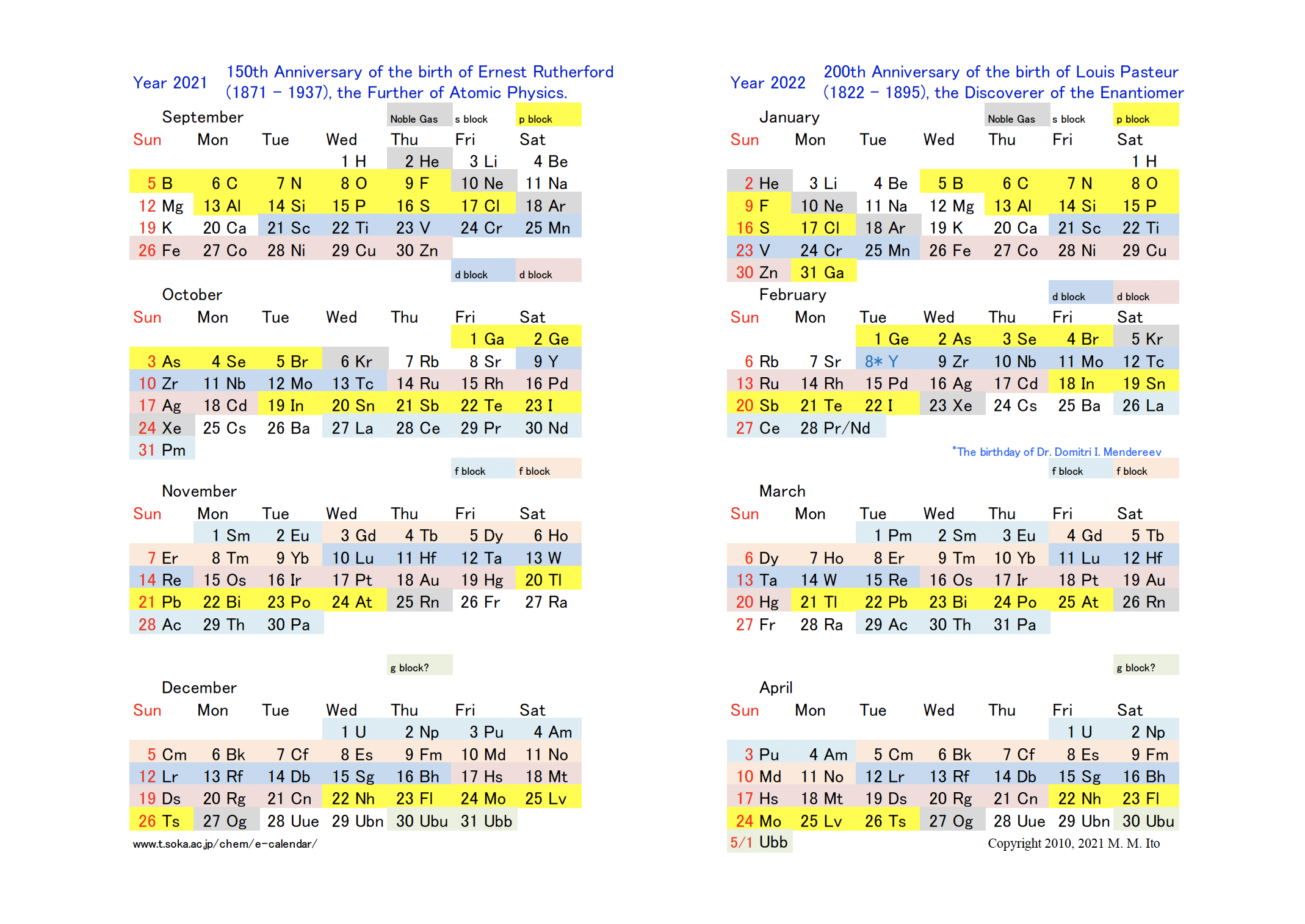(Two-page Sample)


What is today's element? What is your "birth-element"?
What is your red-letter-day element?
Elements Calendar answers these kinds of questions.
Suppose that one year consists of 366 days, one can allocate the 1st to 122nd elements to each day of ca. four months, starting from January 1. Thus, one year corresponds to the three turns of the 1st-122nd elements. As the result, there are three days to which the same element is allocated in one year.
Although the 113, 115, 117, and 118th elements were officially approved in 2016 and further efforts in preparing larger nuclei are in progress, this idea of Elements of the Day will be available for quite a long time, until the discovery of the 123rd element and its authorization, namely, the determination of its elementary symbol.
Please find the elements of your red-letter days, such as your birthday. Do not mind, however, in case the element is not popular in your daily life, for all the elements are universal in that they have existed in the universe. In addition, most of them are indispensable in your body to keep your life alive, or play an important role, somewhere in your daily life. We will be happy if you become a bit more acquainted with chemistry by finding the elements of your red-letter days.
The idea of Elements Calendar came up inspired by "2011, International Year of Chemistry".
2024 Version featured the 250th Anniversary of the Discovery of Oxygen, Chlorine, and Manganese (1774)
2022 Version featured the bicentennial Anniversary of the birth of Louis Pasteur (1822 - 1895), the Discoverer of the Enantiomer
2021 Version featured the 150th Anniversary of the birth of Ernest Rutherford (1871 - 1937), the Further of Atomic Physics.
2019 Version featured the 150th Anniversary of the first report of the Periodic Table by Mendereev, and International Year of the Periodic Table of Chemical elements adopted by the UNESCO.
2018 Version featured the Centennial of the birth of Dr. Ken-ichi Fukui (1918 - 1998), the first Nobel Laureate in Chemistry in 1981.
2016 Version featured Centennial of "The
Atom and Molecule" by G. N. Lewis on Chemical Bonds and Valencies:*
Lewis proposed in this monumental paper the "rule of eight"
to explain the bonding of both ionic and molecular compounds.
It helped deepen the theoretical background of periodic law and
to guide the insights in introduction of quantum theory to molecular
structures and chemical bondings. His name is currently featured
in, for instance, "Lewis structure" and "Lewis
acid and base".
* G. N. Lewis, J. Amer. Chem. Soc., 38, 762-785
(1916).
2015 Version featured Centennial of the Death of Dr. Henry Moseley (1887 - 1915),
the Founder of Atomic Number:
August 10, 2015, was the centennial of the day when Dr. Henry
Mosely was killed in the World War I. The element of the day happens
to be Mendelevium (Md), named after Dr. Mendeleev, the major contributor
to the discovery of the Periodic Law.
Just as if mourning Dr. Moseley, no one was nominated for the Nobel Prize in either physics or chemistry in 1916; he would have deserved as the laureate at least either, or even both, of the prizes in the year, which would have been the first and the last ever since in the history of the prize with the supreme honor.
Thinking back the War that killed the exceptional genius as young as 27, we cannot help wishing that the humankind should never repeat the war, the silliest action.
2014 Version featured the bicentennial of the Proposal of Current Notation of the Elementary Symbols by Berzalius.
2013 Version featured the centennial of the Discovery of Moseley's law on Characteristic X-ray
2012 Version featured the centennial of the Discovery of X-ray Diffration.
Created, 25 December 2010 by Masato M. ITO (Soka University)
Last updated 6. January 2026.